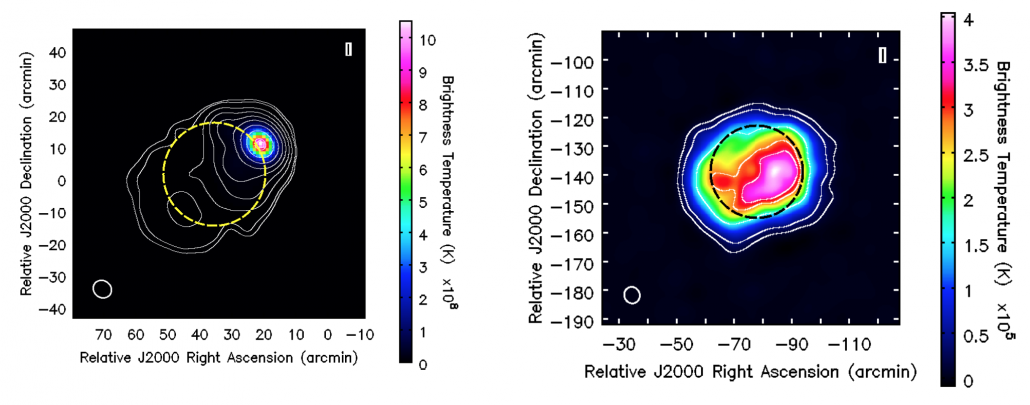Imaging the sun at radio wavelengths with high fidelity is an intrinsically hard problem. This stems from: a) the large range of angular scales on which the emission is present; b) the huge difference in brightness temperature associated with the various emission mechanisms which are responsible for radio emission; and c) high variability of solar emission on small temporal (<1s) and spectral (~kHz) scales. These together imply that the uv plane should be sufficiently sampled in a single snapshot over a narrow bandwidth so as to faithfully capture the emission at all the scales involved. Only with the advent of the new generation of instruments like the Low Frequency Array, Murchison Widefield Array (MWA), Atacama Large Millimeter/Submillimeter Array, this stringent requirement is being fulfilled. All these arrays have a large number of baselines which leads to a densely sampled uv plane even in a single spectral and time slice. However, due to its intrinsic nature, data from these instruments are very voluminous. Manual analysis of these data, which is the norm in traditional radio interferometry, is very time and human effort consuming, and impractical. On the other hand, scientific merits of these data are now well established. Hence it is the need of the hour to develop an automated imaging pipeline which can produce high fidelity solar images in a reasonable amount of time. The need for such a pipeline will only get more acute with the advent of future generation telescopes like the Square Kilometer Array.
Solar imaging at low radio frequencies departs from conventional interferometric imaging in several significant ways. For example, the calibrator sources used are often far away from the sun so that the solar flux density does not contaminate the calibrator observation. In arrays which have a very large field of view like the MWA, calibrator sources need to be observed when the sun is below the horizon. This implies that the gain settings inferred from the calibrator observations is often not very accurate which leads to degradation in the image quality. Self-calibration is a method which solves for both the source model and the antenna gains, and can be used to correct for the differences between the true antenna gains and those obtained from calibrator observations. This is generally difficult to apply in the case of the sun due to its large and morphologically complex structure on the one hand, and the poor initial model obtained from the sub-optimal initial calibration solutions on the other. Even where self-calibration of the sun was successful, the antenna gains were usually assumed to be constant over several minutes and large bandwidths. This was mainly because of the tedium involved in performing self-calibration for every time and frequency slice being imaged. An automated pipeline with a robust self-calibration algorithm which can deal with data from a large range of solar conditions is essential for science exploration of the data being provided by new generation instruments like the MWA.
With these objectives in mind, we have developed the “Automated Imaging Routine for Compact Arrays for the Radio Sun” (AIRCARS). AIRCARS is an easy to use software and is built on CASA. It is also completely parallelised. AIRCARS is designed such that it tries to hide the nitty-gritty of inteferometric imaging from a not so well informed user, while giving ample freedom and flexibility over the details of the imaging procedure and the various choices made to a more advanced user. AIRCARS can be tuned to image a large dataset while optimising for run time, or it can be tuned to push the image quality to the limits ignoring the computational burden aspects. AIRCARS is designed to work best when used with data from an array having a dense core, like the MWA or the future SKA Low.

Figure 1 Left panel: Image during a type II burst. Dynamic range(DR) ~105. Right panel: During a very quiet time. DR ~1000. The brightness temperature range covered in these two images is about 104.
In Figure 1, we show solar images at two extreme conditions made using AIRCARS: for a very active and a quiet time. These images were made by pushing AIRCARS to its limits without regard to the computation time and represent the state-of-the-art. In more typical conditions, when the sun was neither very active nor very quiet and AIRCARS was tuned to optimise computational time, we were routinely able to achieve a dynamic range exceeding 1000.
Conclusions
These images together showcase the ability of AIRCARS to make high dynamic range images. AIRCARS represents our first steps in the direction of making solar radio interferometric imaging analysis accessible to the non-specialist. We hope that the new science phase space opened up by these high dynamic range images from AIRCARS using MWA data will kindle the interest of the larger solar community in the observations in the radio bands.
Based on the recent paper: Mondal Surajit, Mohan Atul, Oberoi Divya, et al. 2019, ApJ, 875, 97
*Full list of authors: Surajit Mondal, Atul Mohan, Divya Oberoi, John S. Morgan, Leonid Benkevitch, Colin J. Lonsdale, Meagan Crowley, and Iver H. Cairns
